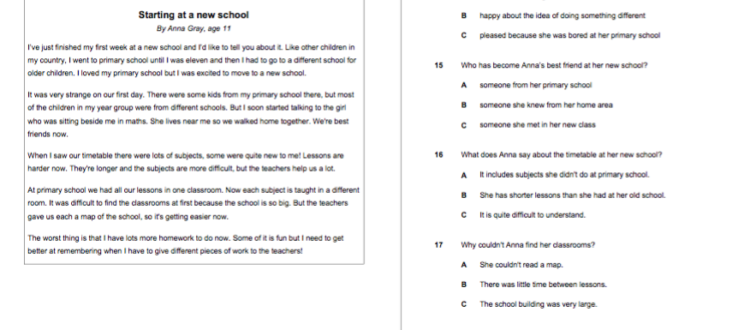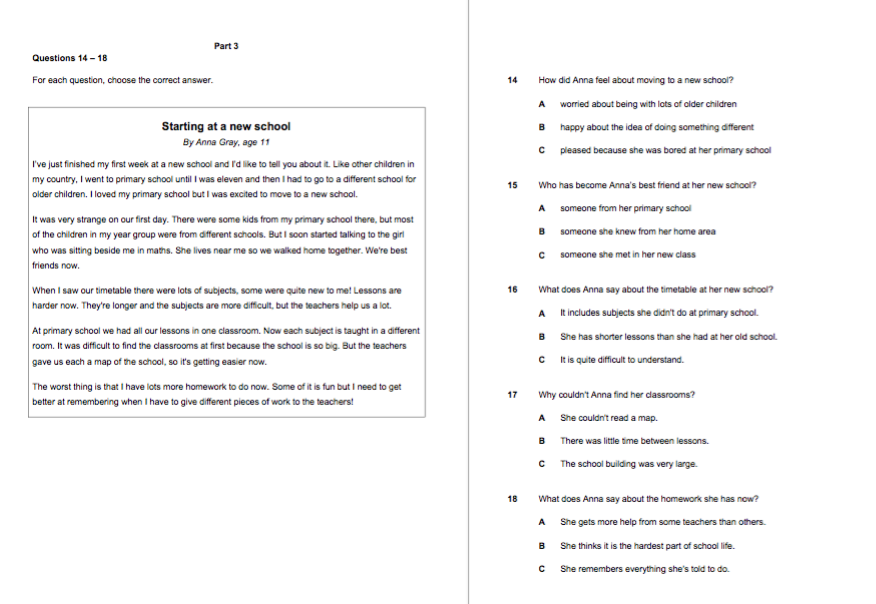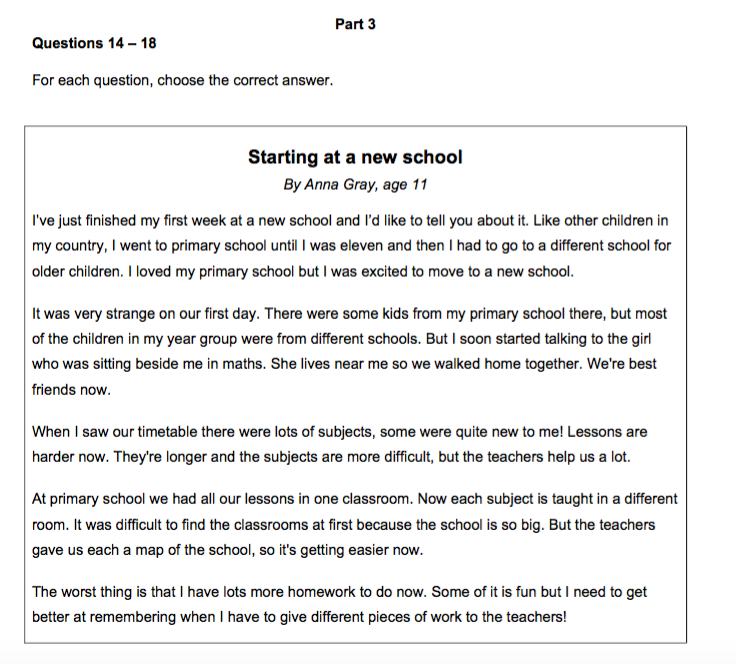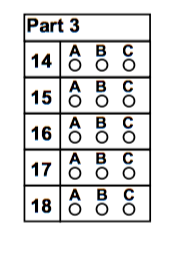About A2 Key Reading Part 3 and how to do it
Today, I’ll analyse A2 Key Reading Part 3 and give some tips on how students can approach it.
In Part 3 of the A2 Key Reading and Writing test, students have to read a longer text and choose the answer to five multiple choice questions (from three options). Let’s take a look at the task from the Sample Paper for A2 Key for Schools, available here.
As always, the first thing to notice is the order that this task is printed in. First, we see the text, then the multiple choice questions. This indicates that the first thing that students should do is to read the whole text before they try and answer the questions.
I always ask students to look at the verbs. Texts like these (and stories too) often start off in the past and finish with the present, or even looking to the future. This one does that too.
We start with the background of Anna’s primary school.
Then, she tells us about her first week and the things that happened and compares some things to her old school.
And we end with a reflection and something that she needs to start doing – a future plan/intention.
Next, I tell students to read each question only (not the options) and to look for the answer in the text.
The questions at this level test detailed understanding and main ideas. There are no questions testing inference or global meaning. Students should be able to find a match for every question in the text.
If doing the paper version of the exam, I’d tell students to underline the part of the text where they found the answer to the question. Sometimes, the answer is in one sentence, but other answers might span a couple of sentences in the text.
Then, I tell students to find which of the three options match the part of the text that they underlined.
Everything in the option has to match the information in the text. Sometimes, there is a partial match, but not everything is the same.
And Cambridge Assessment use a testing tool called distraction. Partial matches, or using words that appear in the text to distract students if they are not careful. This is called ‘wordspotting’ and my tip is that if you can ‘wordspot’ (find the same word in an option and in the text), then it’s probably not the right option!
And another tip I’d give is: If you can’t find the right answer, try eliminating the wrong options, or at least one of them.
Let’s analyse the questions and the options.
14 How did Anna feel about moving to a new school?
A worried about being with lots of older children. There is no mention of this, but students might add their own experience here and choose this answer – but Anna doesn’t say this in the text, so it’s wrong!
B happy about the idea of doing something different. This is a paraphrase of ‘I was excited to move to a new school.’
C pleased because she was bored at her primary school. Like A, there is no mention of this, but students might add their own experience here and choose this answer – but Anna doesn’t say this in the text, so it’s wrong!
15 Who has become Anna’s best friend at her new school?
A someone from her primary school There is a ‘wordspot’ here – primary school. But students would probably not choose this option because it is clear that the girl didn’t go to her primary school.
B someone she knew from her home area Students may well choose this option because it is partially true – the girl is from her home area, but she didn’t know her before she met her in maths class.
C someone she met in her new class She ‘started talking to the girl who was sitting beside me in maths.’ So, she hadn’t met her before.
16 What does Anna say about the timetable in her new school?
A It includes subjects she didn’t do at primary school ‘lots of subjects, some were quite new to me’
B She has shorter lessons than she had at her old school No – she says that they’re longer.
C It is quite difficult to understand Some of the subjects are difficult to understand, but the timetable isn’t.
17 Why couldn’t Anna find her classrooms?
A She couldn’t read a map No – but students might ‘wordspot’ the word map, which is mentioned.
B There was little time between lessons No mention of this – again, students might use their own feelings and choose this answer, but Anna does not say this.
C The school building was very large ‘the school is so big.’
18 What does Anna say about the homework she has now?
A She gets more help from some teachers than others no mention
B She thinks it is the hardest part of school life ‘the worst thing is that I have lots more homework to do now.’
C She remembers everything she has to do No – probably she doesn’t. Students might ‘wordspot’ the word ‘remember’.
One final thing to remember to train students to do is to transfer their answers to the answer sheet. For this part, they colour in the circle for the correct answer.
I tell students to do this after they complete each part, rather than waiting till the end and copying the answers then.
Why? Because they might run out of time and the more answers they have on their answer sheet, the better!
And, of course, to put an answer for every question, even if it’s a guess!
To summarise the steps, then:
1 Read the whole text.
2 Read each question and find the part of the text which answers it.
3 Look for a match between the part of the text that you underlined/highlighted and the options.
4 Check that the option you have chosen matches all the information, not just part of it.
5 If you can’t identify the right option, try eliminating at least one of the wrong options.
6 Transfer your answers to the answer sheet after you finish this part.
7 Put an answer for every question – even if it’s a guess!
There is a lesson plan for preparing for this part and for teaching online, available to download here.
And I’d highly recommend this poster with links to Support for Teachers for A2 Key and other exams.




